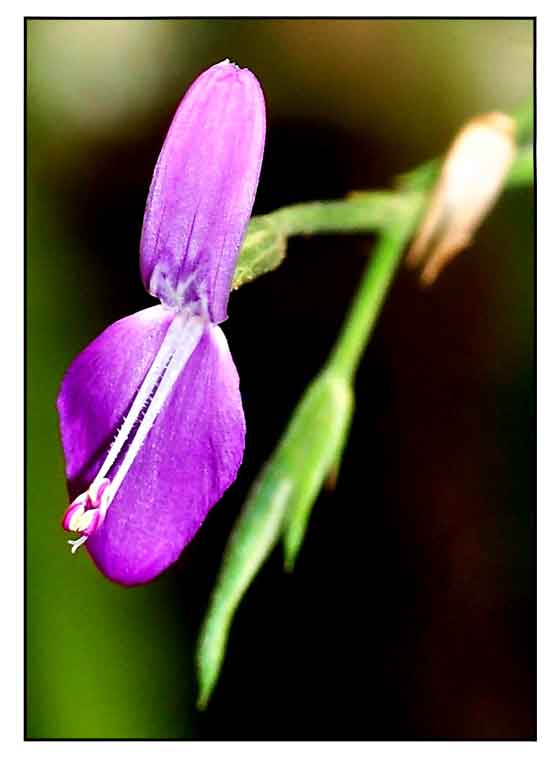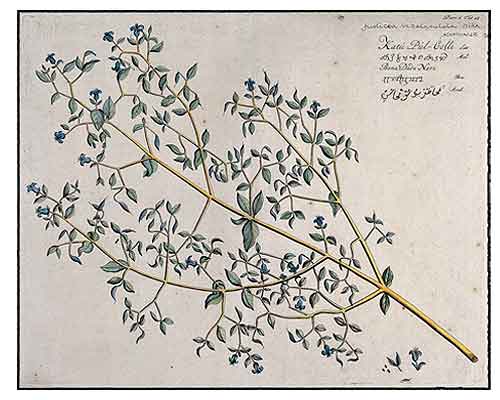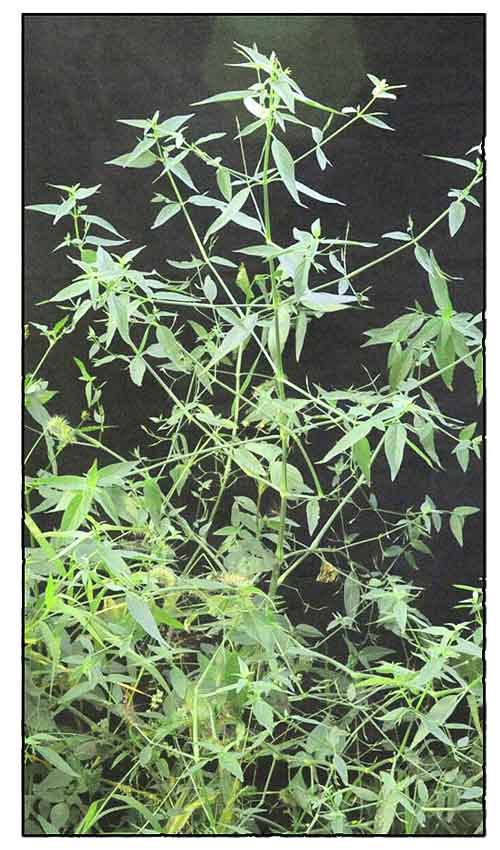Gen info
- Dicliptera is a genus of flowering plants in the bear breeches family, Acanthaceae, containing 223 species native to the tropics and subtropics worldwide.
 Botany Botany
• Herbs to 1.2 m tall, erect, perennial. Stems hirsute, usually 4- or 6-angled. Petiole 3-12 mm; leaf blade ovate to lanceolate, (1-)3-4.5 × (0.5-)1.5-2 cm, abaxially scabrid, adaxially slightly scabrid, base attenuate to broadly cuneate, margin remotely serrulate and slightly ciliate, apex acuminate, acute, or sometimes rounded. Inflorescences of axillary pedunculate cymes with (1-)4(or more) involucres (cymes sometimes branching internally) in axils of leaves or bracts and collectively often forming a terminal leafy panicle-like complex; rachis and inflorescence branches pubescent; outer involucral bracteoles unequal, abaxially pubescent with gland-tipped (sometimes absent) and non-glandular trichomes, larger outer involucral bracteole ± linear, ca. 10 × 2 mm, 1-veined, and apex acute and mucronate, shorter outer involucral bracteole subulate to lanceolate, ca. 6 × 0.1 mm; inner involucral bracteoles narrowly linear to subulate, unequal in length. Calyx lobes lanceolate, ca. 3 mm, outside sparsely pubescent with non-glandular trichomes, inside sparsely pubescent with sessile gland-tipped trichomes, margin membranous at base, apex long acuminate. Corolla light to dark purple, ca. 1 cm, outside pubescent with non-glandular trichomes; tube basally cylindric for ca. 5 mm; lip in lower position narrowly elliptic, 5-7 × 1-2 mm, apex emarginate; lip in upper position elliptic, 3-7 × 2-3 mm, 3-lobed. Staminal filaments ca. 5 mm, white hairy; anther thecae ovoid, superposed, not touching. Ovary ovoid, pubescent and glandular; style glabrous; stigma 2-lobed. Capsule 0.9-1.3 cm, pubescent with non-glandular trichomes. Seeds 2.2-2.5 mm, rough and tuberculate. (Flora of China)
Distribution
- Native to the
Philippines. (1) (2)
- Also native to Assam, Bangladesh, Benin, Botswana, Burkina, Cambodia, Cameroon, Cape Verde, Chad, China South-Central, China Southeast, Djibouti, East Himalaya, Egypt, Eritrea, Ethiopia, Gambia, Gulf States, India, Kenya, Laccadive Is., Malawi, Mali, Mauritania, Mozambique, Myanmar, Namibia, Nepal, Niger, Nigeria, Oman, Pakistan, Saudi Arabia, Senegal, Socotra, Somalia, Sudan, Tanzania, Thailand, Uganda, Vietnam, West Himalaya, Yemen, Zambia, Zimbabwe. (1)
 Constituents Constituents
- Phytochemical analysis using hexane, ethyl acdtate, and hydroalcoholic extracts revealed presence of carbohydrates in stems; sterols and carbohydrates in leaves, terpenoids, alkaloids, and phenols in roots in all extracts.
- Phytochemical analysis using hexane, ethyl acetate, and hydroalcoholic extracts revealed presence of carbohydrates in stem; sterols and carbohydrates in leaves; terpenoids, alkaloids, phenols in all extracts. (see study below) (5)
- Hyrdodistillation and GC-MS study of Peristrophe bicalyculata for volatile oils yielded beta-caryophyllene (33.9%), alpha-zingiberene (10.4%), germacrene D and globulol (5.0%) in abundance. (see study below) (9)
- Phytochemical analysis of ethanolic leaf extract showed presence of alkaloids, tannins, carbohydrates, steroids/triterpenoids, saponins, coumarins, flavonoids, and fixed oils, with absence of anthraquinone glycoside, cyanogenetic glycosides, cardiac glycosides, proteins and amino acids. (see study below) Â (11)
Properties
- Plant considered stimulant, stomachic, and diuretic.
-
Studies have suggested antibacterial, cytotoxicity, anticancer, CNS central depressant, anticonvulsant, anticataract properties.
Parts used
Leaves, roots, seeds.
 Uses Uses
Edibility
- No reports on edibility for human use.
Folkloric
- No reported folkloric medicinal use in the Philippines.
- Leaves used to treat eye and ear diseases, bacterial infections, and as antidote to insect stings and bites. (5)
- In Unani medicine, used for treatment of colds, fever, cough, insomnia, headache, leucorrehea, sprains, and snake poisoning. Also used in psychosomatic disorders, gynecological, tuberculosis, and lung diseases. (6)
- In Madhya Pradesh, India, used for treatment of snake bites. Roots, seeds, or entire herb used in various Ayurvedic formulations. In traditional Indian medicine, also used for treatment of liver disorders, rheumatism, and gout, and as anti-nematode. Also used for headaches, snakebites, sprains and bone fracture, glandular swelling, and cardiovascular diseases. (6)
- In Nigeria, leaves chewed for treatment of diabetes.
- In Ayurvedic medicine, leaf paste applied externally to bone fractures; paste of whole plant mixed with salt applied to sprains and fractures; fresh leaf juice used for conjunctivitis, poultice of leaves applied to skin diseases; root paste applied to ulcerative, suppuration, malodorous wounds. (12)
Others
- Veterinary: Used for treatment of eye infections in cattle.
- Fodder: Leaves used as horse fodder.
Studies
• Antibacterial / Molecular Docking: Study evaluated D. paniculata for novel antibacterials. A petroleum-ether fraction of methanol extract subjected to GC-MS analysis identified 14 compounds. Several target proteins were used for molecular docking. Antibacterial activity of the PE-fraction was evaluated on bacteria whose target protein interacted most strongly with identified molecules. Molecules DP_02, DP_06, and DP_14 exhibited highest docking scores with Staphylococcus aureus dihydrofolate reductase. Validation of findings on antibacterial effectiveness against S. aureus showed encouraging results. The two molecules, DP_02 and DP_06 might serves as building blocks for future development of potent antibiotics. (3)
• Cytotoxicity Against Cancer Cell Lines / Leaves: Study evaluated the cytotoxic activity of leaves of six plants used in Nigerian ethno-medicine for cytotoxicity against four cancer cell lines (A549, RD, MCF7, and HeLa) and the molecular pathway of cytotoxic action. Dicliptera paniculata and Uvaria chamae extracts exhibited good cytotoxicity across all cell lines in a time- and concentration-dependent manner (CC50 <30 µg/mL). Increased pro-apoptotic BAX and lowered expression of anti-apoptotic Bcl-2 showed cytotoxic action followed the intrinsic apoptotic pathway. Increased expression of caspase3 indicated the intrinsic apoptotic pathway was caspase-dependent. Results highlights apoptosis as a molecular pathway of cytotoxicity. (4)
• Antibacterial / Cytotoxicity: Study of ethanolic extract of P. paniculata showed inhibition of growth of E. coli, Bacillus cereus, and S. aureus. Leaf and stem extract significantly reduced radial growth of Colletotrichum capsicum. P. bicalyculata extracts can induce cytotoxicity and cell death in cancer cells, able to target cancer cells more selectively. Methanolic extract increased antioxidant capacity and prevented neuroinflammation in experimental animals. (see constituents above) (5)
• Anticonvulsant Effect: Study evaluated the neuro-pharmacological effect of aqueous extract of P. bicalyculata using supra-maximal electro-shock induced seizures and Pentobarbitone-sodium Induced sleeping time in albino rats. Rats were administered 25 mg/100 g bw. Results confirmed the central depressant effect of the test drug in the animal model, and affirmed the anti-psychiatric and prompt anticonvulsant activity of the drug. (7)
• Antidiabetic Effect: Study evaluated the effect of Peristrophe bicalyculata powder on diabetic and lipid parameters in stomach of rats. Treatment group showed appetite suppression and lethargic movement. Treatment with P. bicalyculata reduced stomach weight of animals and significantly reduced (p<0.05) levels of glucose, insulin, protein, cholesterol, and triglycerides. The decrease in body weights was attributed to decreased food intake due to appetite suppression, faint aromatic smell, and tastelessness. P. bicalyculata is known to cause suppression of receptor of sweet taste on the tongue. (8)
• Antimicrobial / Cytotoxicity / Essential Oil: Hyrdodistillation and GC-MS study of Peristrophe bicalyculata for volatile oils yielded beta-caryophyllene (33.9%), alpha-zingiberene (10.4%), germacrene D and globulol (5.0%) in abundance. Volatile oils displayed in-vitro cytotoxicity to MCF-7 (human breast tumor) and MDA-MB-468 (human breast tumor) cells. The volatile oils also exhibited promising in-vitro antimicrobial activity against test microorganisms. (9)
• Chronic Oral Toxicity Study / Whole Plant: Study evaluated the chronic oral toxicity (90 days) of aqueous and methanol extracts of whole plant of P. paniculta using dosage of 200 mg/kg/day on Wistar rats. No significant mortality was observed. Both extracts showed to be devoid of any toxicity at dose level studied. (10)
• Anti-Cataract Potential / Leaves: Study evaluated the antioxidant and anticataract potential of D. paniculata alcoholic extract of leaves using diabetes-induced cataract in goat eyes. Results showed promising results in reducing diabetes-induced cataracts. Extract significantly increased protein and potassium levels, and reduced sodium level. The HET-CAM study showed the extract has no irritant. (see constituents above) (11)
Availability
- Wild-crafted.
|

![]()



 Botany
Botany Constituents
Constituents
